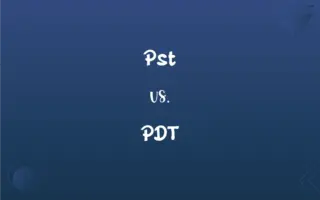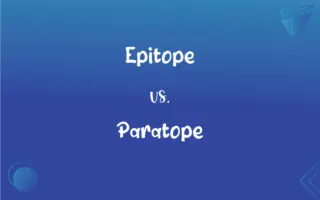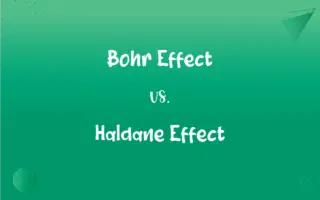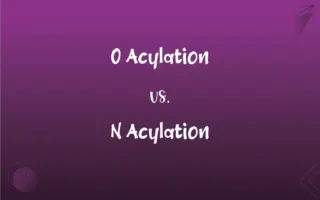Kwashiorkor vs. Marasmus: What's the Difference?
Edited by Aimie Carlson || By Harlon Moss || Updated on October 13, 2023
Kwashiorkor involves protein deficiency with adequate calorie intake, causing edema, while marasmus is characterized by overall nutritional deficiency, leading to significant weight loss and muscle wasting.

Key Differences
Kwashiorkor and marasmus both represent forms of severe malnutrition but manifest through different physiological responses. Kwashiorkor is particularly associated with protein deficiency even with sufficient calorie intake, typically observable through edematous malnutrition, where the affected individual exhibits swelling (edema), particularly in the abdomen. Marasmus, on the other hand, reflects a stark deficiency in overall caloric intake, marked by substantial muscle wasting and drastic weight loss.
In cases of kwashiorkor, despite a seemingly adequate calorie intake, the lack of protein creates a specific form of malnutrition, characterized by a distinctive swollen belly, often accompanied by changes in skin pigmentation and hair discoloration. Contrastingly, marasmus predominantly arises from a generalized deficiency in nutrient and calorie intake, causing the body to consume its own muscle and fat reserves, resulting in a visibly emaciated appearance, with minimal to no noticeable edema.
It’s crucial to observe that kwashiorkor often manifests with an individual maintaining some degree of adipose (fat) tissue, despite the prominent abdominal swelling. Marasmus, however, essentially depletes the body’s fat reserves, highlighting pronounced skeletal visibility, and is frequently associated with a weakened immune system and potential for severe infection.
Treatment for kwashiorkor typically involves the gradual reintroduction of proteins into the diet, coupled with managing electrolyte imbalances that often accompany the disorder. Conversely, addressing marasmus usually necessitates the cautious administration of a nutritionally complete diet, ensuring all essential nutrients, including proteins, fats, and carbohydrates, are adequately provided to gradually rebuild the individual’s nutrient stores and physical health.
While kwashiorkor and marasmus can be particularly prevalent in regions grappling with famine and food scarcity, they're not exclusive to such areas, and can manifest wherever dietary intake is insufficiently managed or available, demanding meticulous nutritional rehabilitation for affected individuals in both scenarios.
ADVERTISEMENT
Comparison Chart
Primary Deficiency
Protein despite adequate calories.
Overall calories and nutrients.
Physical Appearance
Edema, particularly in the abdomen.
Severe muscle wasting, emaciated look.
Fat Reserves
Sometimes maintained.
Mostly depleted.
Hair and Skin Changes
Often present (e.g., hair discoloration).
Not typical.
Typical Onset Age
Usually in young children after weaning.
Can occur in infants and young children.
ADVERTISEMENT
Kwashiorkor and Marasmus Definitions
Kwashiorkor
Kwashiorkor is a form of malnutrition mainly caused by protein deficiency.
Despite sufficient caloric intake, the child developed kwashiorkor due to lack of protein.
Marasmus
Marasmus arises from a generalized deficiency in calorie and nutrient intake.
The child, severely underweight and weak, was diagnosed with marasmus.
Kwashiorkor
It typically exhibits as edema, especially noticeable in the abdominal area.
The notable abdominal swelling indicated a probable case of kwashiorkor.
Marasmus
It leads to substantial muscle wasting and significant weight loss.
Marasmus caused her to lose a dangerous amount of weight and muscle.
Kwashiorkor
Kwashiorkor can present with skin and hair changes, such as discoloration.
The physician noticed hair discoloration, a possible sign of kwashiorkor.
Marasmus
Marasmus treatment involves carefully managed nutritional rehabilitation.
She was hospitalized to manage her marasmus, initiating a carefully structured dietary plan.
Kwashiorkor
It occurs often in young children, especially after weaning.
Post-weaning, insufficient protein led to the toddler developing kwashiorkor.
Marasmus
Marasmus can severely weaken the immune system, elevating infection risk.
His marasmus not only caused weight loss but also heightened susceptibility to infections.
Kwashiorkor
Managing kwashiorkor involves careful dietary management and often, hospitalization.
Treatment for his kwashiorkor included gradual protein reintroduction and monitoring.
Marasmus
It can manifest in both infants and young children due to malnourishment.
Infants, like young children, are also vulnerable to marasmus if not adequately nourished.
Kwashiorkor
Severe protein malnutrition, especially in children after weaning, marked by lethargy, growth retardation, anemia, edema, potbelly, skin depigmentation, and hair loss or change in hair color.
Marasmus
A progressive wasting of the body, occurring chiefly in young children and associated with insufficient intake or malabsorption of food.
Kwashiorkor
(pathology) A form of malnutrition, found in children, caused by dietary insufficiency of protein in combination with a high-carbohydrate diet.
Marasmus
(medicine) A condition of chronic undernourishment especially in children, caused by a diet deficient in calories or the inability to digest protein and presenting as a severe loss of body weight.
Marasmus senilis
Kwashiorkor
Severe malnutrition in children resulting from a diet excessively high in carbohydrates and low in protein
Marasmus
A wasting of flesh without fever or apparent disease; a kind of consumption; atrophy; phthisis.
Pining atrophy,Marasmus, and wide-wasting pestilence.
Marasmus
Extreme malnutrition and emaciation (especially in children); can result from inadequate intake of food or from malabsorption or metabolic disorders
FAQs
What defines marasmus?
Marasmus is characterized by a severe deficiency in overall calorie and nutrient intake, leading to muscle wasting.
Can marasmus affect adults?
While marasmus commonly affects infants and children, adults can also be impacted, especially in severe malnutrition scenarios.
Are there distinctive physical signs of kwashiorkor?
Yes, kwashiorkor frequently exhibits physical signs like abdominal swelling, hair discoloration, and sometimes skin issues.
How is kwashiorkor identified?
Kwashiorkor is often identified by swelling (edema), especially in the abdomen, and changes in skin and hair.
Is kwashiorkor only prevalent in impoverished regions?
While common in areas with food scarcity, kwashiorkor can occur anywhere where protein intake is insufficient.
Can kwashiorkor and marasmus occur simultaneously?
Yes, an individual can experience "marasmic kwashiorkor," showing symptoms indicative of both conditions.
Does marasmus always result from starvation?
Marasmus is largely associated with starvation but can also stem from malabsorption issues or dietary neglect.
How does marasmus impact long-term health?
Marasmus can lead to permanent issues, like stunted growth and weakened immunity, if not addressed promptly.
What demographics are commonly affected by kwashiorkor?
Kwashiorkor often affects young children, especially after being weaned from breastfeeding.
How does marasmus affect physical appearance?
Marasmus leads to a visibly emaciated appearance with notable muscle wasting and minimal to no body fat.
Can marasmus be fatal?
Yes, marasmus can be life-threatening, especially without timely intervention and nutritional rehabilitation.
Is edema present in marasmus?
No, edema is not typically associated with marasmus, which is primarily characterized by muscle wasting.
How quickly does marasmus develop?
Marasmus can develop gradually over time due to sustained inadequate nutritional intake or more rapidly in acute starvation.
Can marasmus be reversed?
With timely, appropriate nutritional intervention, the effects of marasmus can often be reversed, though some impacts, like stunting, may be permanent.
What causes kwashiorkor?
Kwashiorkor is caused by inadequate protein intake despite sufficient calorie consumption.
Can kwashiorkor lead to developmental issues?
Yes, kwashiorkor can cause developmental delays and impairments, particularly in children.
Are there cognitive impacts of kwashiorkor?
Kwashiorkor can affect cognitive development and function, particularly in children who experience it.
Are there preventive measures for kwashiorkor?
Ensuring adequate protein intake, especially in young children’s diets, is pivotal for preventing kwashiorkor.
How do you treat kwashiorkor?
Kwashiorkor is typically treated with gradual protein reintroduction and careful management of potential electrolyte imbalances.
What’s the primary focus for treating marasmus?
Marasmus treatment focuses on the cautious reintroduction and escalation of nutrient-dense foods and calories.
About Author
Written by
Harlon MossHarlon is a seasoned quality moderator and accomplished content writer for Difference Wiki. An alumnus of the prestigious University of California, he earned his degree in Computer Science. Leveraging his academic background, Harlon brings a meticulous and informed perspective to his work, ensuring content accuracy and excellence.
Edited by
Aimie CarlsonAimie Carlson, holding a master's degree in English literature, is a fervent English language enthusiast. She lends her writing talents to Difference Wiki, a prominent website that specializes in comparisons, offering readers insightful analyses that both captivate and inform.






































































